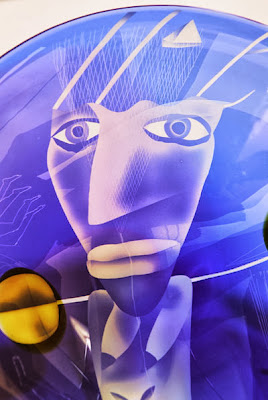 |
| © Erwin Eisch / CMOG |
Is it a new 8 member boy band created from TV show "X Factor"? No.
Still photo from the latest sequel to a Hollywood slasher/gore film? Nope.
Some Portland hipsters gathering at a coffee café that doubles as a low-carbon-footprint bike shop? Wrong Again.
European glass innovator Erwin Eisch made the 8 mold blown works as a tribute to Harvey Littleton in 1976. Eisch’s non-traditional approach to glassmaking had a profound impact during the formative years of the American Studio Glass movement, and his relationship with American glass pioneer Harvey K. Littleton forged an important link between European and American studio artists working in glass.
Want to know more about the history of Studio Glass? This Saturday, October, 5, from 1 pm, the Debra Ruzinsky of the Washington Glass School will talk and show images presenting a broad international survey rooted in the early days of studio work. Works by artists Sybren Valkema, Edris Eckhardt, Michael and Francis Higgins, Libensky and Brychtova, Ann Wolff, Erwin Eisch, Kyohei Fujita, Vera Liskova, to name a few early & influential artists -- such as female glass artist Asa Brandt, who has been called the "Harvey Littleton of Sweden".
This free talk is a great way to know who and where glass has come as we move boldly into a new future of the medium.
 |
| BLUE MADONNA by Ann Wolff |
What Came Before / A Slide History Of The Studio Glass Movement
Lecturer : Debra Ruzinsky
When : Saturday,October 5th
From:1 pm
Cost : Free of charge...RSVP to: washglassschool@aol.com
Where: Washington Glass School
3700 Otis Street, Mount Rainier, MD 20712
Where: Washington Glass School
3700 Otis Street, Mount Rainier, MD 20712
(A) Littleton the Gentleman: mirrored inside, with glasses, with marble base. (B) Littleton the Poet: with glasses and beanie. (C) Littleton the Teacher: mirrored inside, glassblower painted on right side of head; set on square black base. (D) Littleton, Man of Frauenau: cold painted in facial area and around base with scene of town. (E) Littleton the Worker: applied band of colorless glass across nose and around head, square black base. (F) Littleton's Headache: painted with bandages surrounding head and chin area, etched in other areas, square black base. (G) Littleton the Fragile. (H) Littleton's Spirit: with collar and tie.

No comments:
Post a Comment